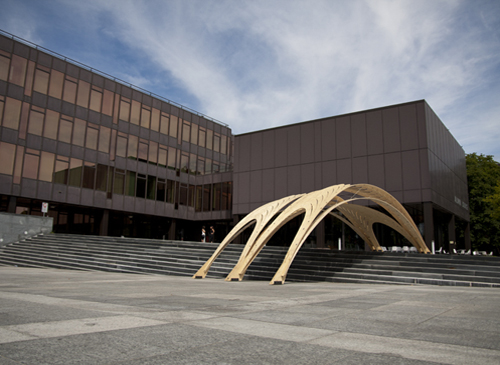|
|
Competition Team: Pierluigi D′Acunto, Norman Hack, Shanky Jain, Alkistis Karakosta, Shibo Ren, Camila Rock De Luigi, Paula Velasco (AA London)
Project Coordinator: Toni Kotnik (ETH Zurich; AA London)
Academic Supervisors: Toni Kotnik (ETH Zurich; AA London), Michael Weinstock (AA London), George Jeronimidis (AA London), Wolf Mangeldorf (Buro Happold, London)
Structural Analysis: Pierluigi D′Acunto, Shibo Ren (AA London)
Structural Consulting: Luke Epp (Buro Happold, London), Joseph Schwartz (ETH Zurich)
Shading Analysis: Yassaman Mousavi (AA London)
Project Management: Darrick Borowski (AA London), Özgür Keles (ETH Zurich)
Fabrication Team: Pierluigi D′Acunto, Gabriel Ivorra, Norman Hack, Shanky Jain, Yassaman Mousavi, Fatima Nasseri, Camila Rock De Luigi, Sebastian Partowidjojo, Paula Velasco, Nicolás Villegas Giorgi, Sherwood Wang (AA London)
Steel Work: Peter Jenni (Metal Workshop D-BAUG, ETH Zurich)
Wood Work: Paul Fischlin, Oliver Zgraggen (Carpentry, ETH Zurich)
Out of a collaboration between the Emergent Technologies and Design program (EmTech) of the Architectural Association, London, and the Chair of Structural Design at the Swiss Federal Institute of Technology (ETH), Zurich, a temporary light timber construction has been design that functions as sun shading for parts of the grand stairs in front of the architecture department of the ETH. It is based on bending behaviour under selfweight of oversized sheets of plywood of up to 11 x 2.5 m. The design activates the material properties as the defining element in the transfer of forces. The exploration of the sheet material and the manipulation of its bending properties by controlling the number of layers of ply and the fibre direction of these layers was the starting point of the design process. The precise geometry of the bending curve emerged out of the distribution of matter, the hierarchy within plywood as composite material and given load conditions.
Based on a systematic investigation into the defining parameters, sheets of 18 mm thickness with fibres mainly in longitudinal direction have been used for the pavilion. Cuts within the sheets influence the bending resistance of the sheets, enable a larger spatial enclosure and reduced wind load acting upon the structure, and additionally produces a shadow pattern on the stairs that are used as seating area during summer time. Varying the length of the sheets generates small variations of the bending curve that have been utilized for the overlapping and interlocking of adjacent elements resulting in a system of self-stabilizing vaults. The vaults are cross-braced by a sequence of cables. These cables distribute all other load conditions evenly within the edge strips, and so reduce additional deformation of the arched form to a minimum.
The design refinement as well as details of the construction and fabrication process of the pavilion have been worked out by a design team of EmTech-students. The initial design idea derived from the winning entry of a competition team during an internal design competition within EmTech. In addition, the work of the design team has been informed by material test and design studies conducted during a workshop of all EmTech students at the ETH. In general, precedents to this field of work commence with the work of Alvar Aalto and Charles Eames in plywood, and the techniques of scoring, cutting and bending to achieve curvature have been established in a variety of materials in jewelry design, surface ornamentation, paper and other craft practices, as well as in airplanes and boats. Recent contributions include Skylar Tibbits’ Surface Ornamentation at the MIT – Massachusetts Institute of Technology (2008), and The Probotics of the AA DRL - Architectural Association Design Research Laboratory (2010).
For more informationlast modified 19.12.2016
